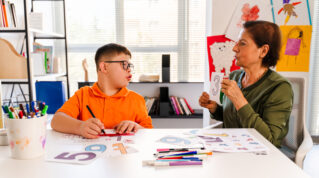The education system’s aim is to be inclusive, but that’s not always the experience of learners with autism spectrum disorder (ASD). Here are some practical things school leaders can consider to help create an autism-friendly school.
Set the culture and communicate
Your school culture starts with you. Make a decision to adopt one that is highly positive, enables autistic and neurodivergent students to succeed, and has communication at its heart.
Communicate with your team about ASD, the needs of individual students and the standards of best practice you want to see in each classroom.
Communicate with parents, too. They are the experts and are key to you gaining a good understanding of their child, what works and what does not.
And talk to the child, find out what is important to them and how to provide the support which will help.
Plan, structure, and teach flexibility
Look at planning and organisation through the lens of an autistic child. If you provide visual information, clear structure and good communication, it will increase confidence, enjoyment and participation. And if you get it right for the autistic child, it is likely to work well for every student in your school.
Some basic things to try include: now and next visual guides, visual timetables and planners, checklists, and playground activity boards with ideas of what to do.
It is also important to promote flexibility and teach strategies for coping with change – for example, through rehearsal or role play. Another useful technique is to encourage students to write down in simple sentences what has changed, why and what will happen instead – as having something visual to refer to can be reassuring and avoid repeated questions.
Understand individual sensory needs
Sensory differences mean some children with ASD can be overwhelmed in certain situations, and may display activities such as rocking, swinging and spinning. These can be used as calming techniques that allow the student to learn, interact with others and manage the day, and so where this is the reason, such behaviours should not be corrected.
Understanding each student’s sensory needs and setting this out in a student passport – that stays with them throughout their school life and is a working document that staff can regularly update and share with others – will help build acceptance and understanding.
Build relationships
Children with ASD may build strong relationships with a limited number of staff and identifying a key point of contact or ‘keyworker’ can be beneficial. This person should invest in the relationship, give their time and show interest. Playing games and having fun is important. Build the relationship in the good times to help in challenging ones.
Behaviours of concern arise for many reasons. Look beyond these and do not take them personally. See all behaviour as communication and establish clear strategies for supporting behaviour, as well as teaching students how to self-regulate.
Audit the environment
Auditing the environment and creating some spaces in the school that are designated as low arousal sensory zones will really make a difference when trying to create an ASD-friendly zone. Bright lighting, sound, clutter and smell can all contribute to making an environment overwhelming.
It may not be possible to change the whole school environment, but having just some low-arousal spaces or quieter zones can make a difference. Get students involved in creating ASD-friendly spaces too.
Prioritise independence
Independence is important because it reduces anxiety, and builds self-esteem and confidence – characteristics students need now and in the future. Embed strategies to scaffold and support pathways to independence.
Make the most of teaching assistants but avoid over-reliance and ‘prompt dependency’, where a student waits to be told what to do next. Instead, ask them, starting with simple questions like what they need to do next and building up to how they can solve the problem. This is important for the independence and self-responsibility they will need to thrive.
Finally, keep listening, learning and being kind (including to yourself!).
With some small changes we can make our classrooms friendly to chidren with autism spectrum disorder and give them an educational experience that is positive and prepares them for happy, independent futures.









Great advice. I’d add that it’s important to help autistic kids learn about their autism and feel positive about it. Good article Jo!